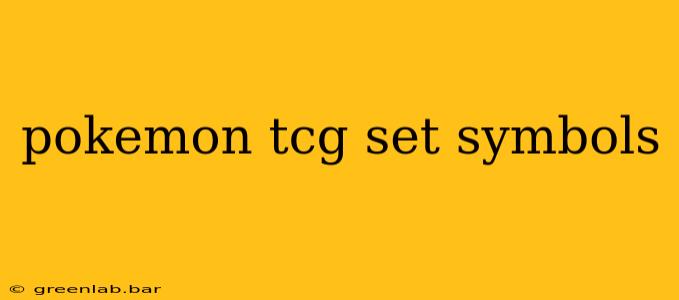The Pokémon Trading Card Game (TCG) boasts a vibrant and evolving world, and a key element of understanding its history and rarity lies within its set symbols. These small but significant icons, often overlooked, tell a story about the card's origin, release date, and even its place within the larger Pokémon TCG narrative. This guide will delve into the intricacies of these symbols, providing a comprehensive understanding for both seasoned players and curious newcomers.
Understanding the Purpose of Set Symbols
Set symbols aren't just pretty pictures; they serve several crucial functions:
-
Identification: The most basic function is identifying the specific expansion set a card belongs to. This is crucial for collectors, traders, and players alike, allowing for easy organization and valuation.
-
Rarity Indication (Indirectly): While not directly indicating rarity (that's the job of the rarity symbols – circles, diamonds, stars etc.), the set symbol, in conjunction with the card's number, can sometimes provide clues about a card’s potential rarity within that specific set. Certain sets are known for having fewer rare cards than others, for example.
-
Historical Context: For collectors, set symbols offer a glimpse into the history of the Pokémon TCG. They act as a timeline, visually representing the evolution of the game and its various expansions.
-
Collectible Value: Knowing the set a card belongs to directly influences its value. Certain sets are highly sought after by collectors, driving up the prices of cards from those expansions.
A Visual Journey Through Pokémon TCG Set Symbols
Over the years, the Pokémon TCG has used a wide array of set symbols. While a complete visual catalog is beyond the scope of this post, we can examine some notable examples and common symbol types:
Early Sets: Simple and Iconic
The earliest Pokémon sets often featured simpler symbols, sometimes directly incorporating the set's name or a thematic element. These symbols were often less detailed but served their purpose effectively in identifying the set.
Modern Sets: Complexity and Detail
As the game progressed, the set symbols became increasingly intricate and visually appealing. Modern sets frequently use stylized logos, incorporating Pokémon imagery or thematic elements related to the expansion's storyline. This increased complexity adds to the collectible appeal.
Regional Variations: Symbols Across the Globe
It's important to note that set symbols can vary slightly based on the region. A card from a Japanese set will have a different symbol than its English counterpart, even if they share the same expansion name. These regional variations can add another layer of complexity for dedicated collectors.
How to Use Set Symbols for Effective Card Identification
Identifying a card's set requires careful examination of the symbol located in the bottom right corner of the card. Compare the symbol to online resources or reference books containing images and information on all Pokémon TCG sets. Websites and apps dedicated to the Pokémon TCG are excellent resources for this purpose.
Beyond the Basics: Advanced Set Symbol Analysis
For experienced collectors, analyzing set symbols can involve comparing different versions of the same set across regions, noting subtle variations in design, and understanding how these variations affect the card's value.
Conclusion: The Unsung Heroes of the Pokémon TCG
The seemingly small set symbols in the Pokémon TCG are far more than just decorative elements. They serve as a crucial link to the game's rich history, a key to identification, and a significant factor in the value and collectibility of individual cards. By understanding these symbols, collectors and players alike can unlock a deeper appreciation for the ever-evolving world of the Pokémon TCG.

